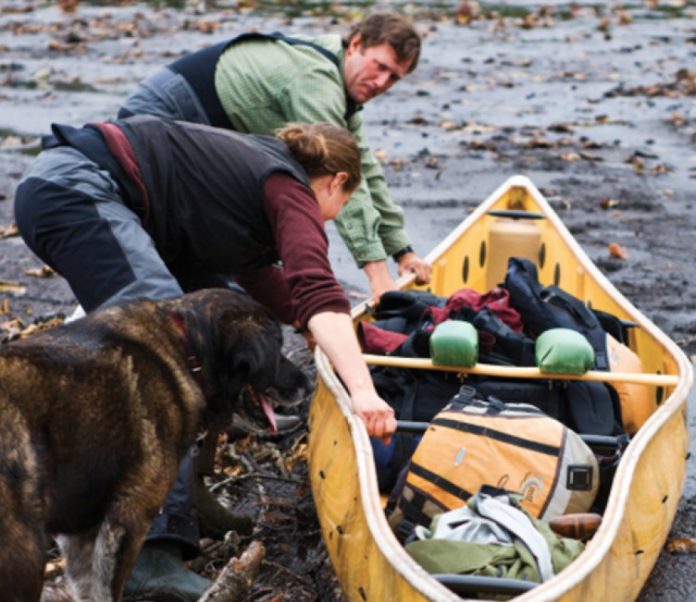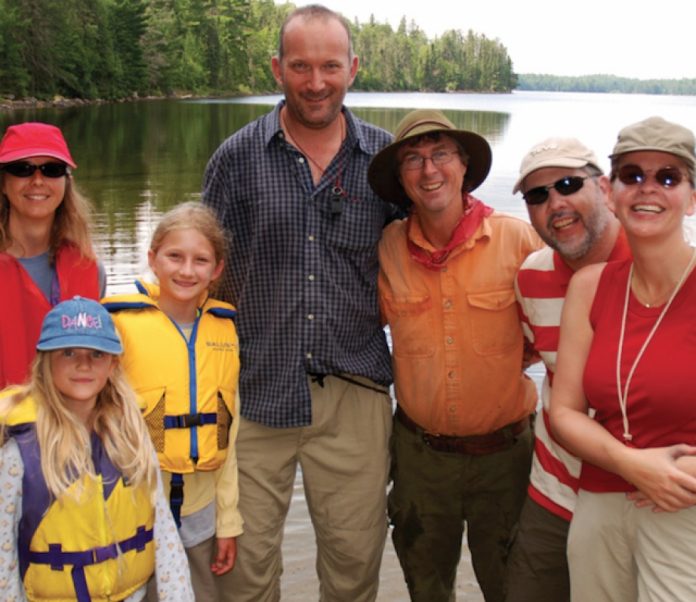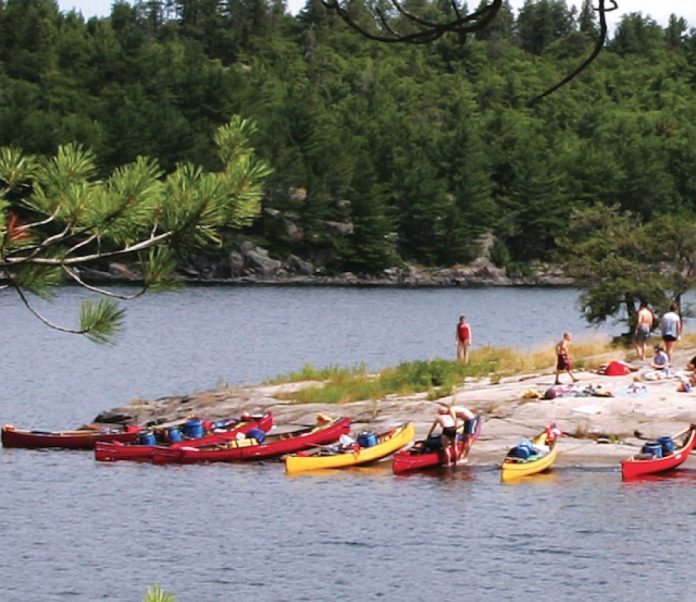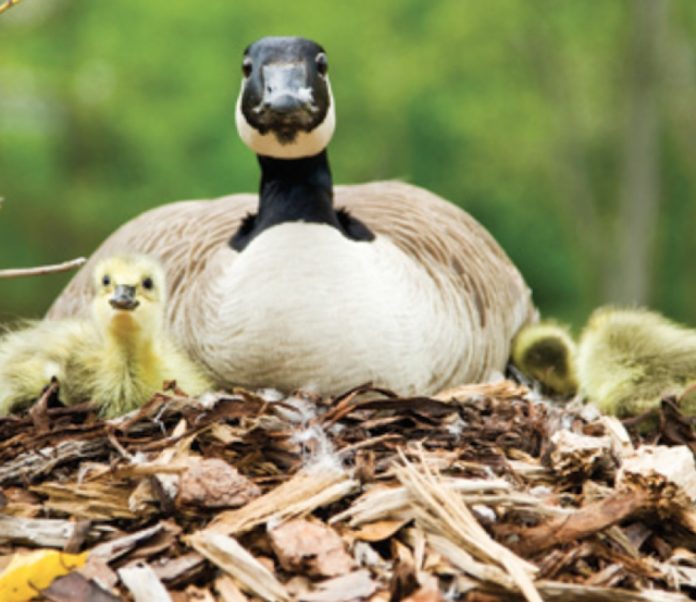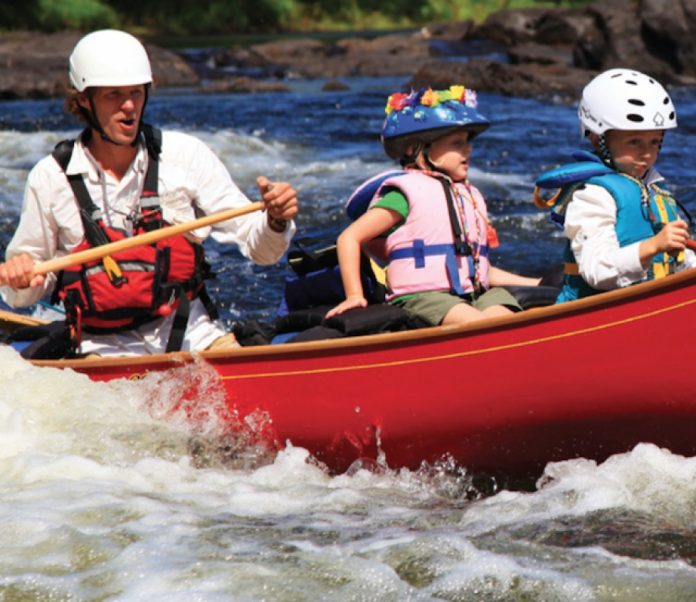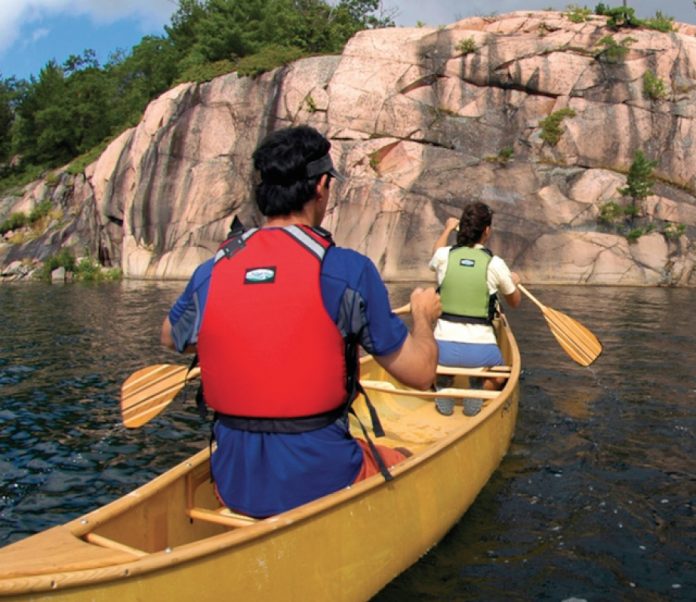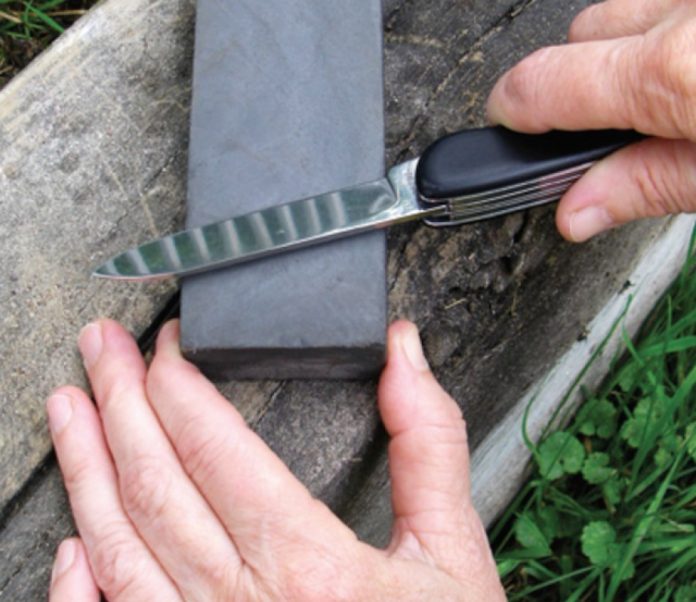“There’s a bear,” Amy Freeman whispered, pointing at the rocky shoreline. I scanned the Canadian Shield granite, hoping to see its hunched, black silhouette walking along the edge of the lake. It wasn’t until Amy and husband Dave’s Kevlar canoe clunked against a boulder at the portage that I spotted the bear. Unfazed by the sound, it poked its nose into the water and pushed around stones, looking for food before the long northern winter set in.
“I hope Fennell doesn’t see it,” said Amy. The Freeman’s 104-pound sled dog has accompanied them on the last 3,900 miles of a three-year, 11,700-mile journey across North America by canoe, kayak and dogsled. They call this trip the North American Odyssey.
I joined them in Voyageurs National Park in October 2011 for the last 20 days of the fourth stage of the expedition, which they hope to complete this year by paddling to Florida. Together, we would paddle to Lake Superior following the Minnesota-Ontario border through the Boundary Waters Canoe Area Wilderness (BWCA).
When we started portaging, the bear turned into the birch forest and ambled away over a ground covered with the season’s last fallen yellow leaves. According to the map, the campsite we wanted was on the opposite side of a peninsula in the exact direction that the bear headed.
By the time we paddled to the campsite, the low-hanging cumulus clouds covering the sky were turning pink with the setting sun. As Amy placed a foot on the sloping granite, I noticed the bear walking away from us.
“We can get another campsite if you want,” offered Dave. Too tired to paddle any more, I said no and we set up camp for the night. Following a routine that they developed over the last year and a half of travel, Amy set up their tent and rolled out their sleeping bags while Dave started cooking dinner.
The North American Odyssey is a Wilderness Classroom Organization (WCO) expedition. Dave founded WCO in 2001 with the simple idea of sharing his expeditions with classrooms online. Now based in a suburb of Chicago, the nonprofit’s mission is to introduce elementary and middle school students to exploration and wilderness travel, and use those themes to help improve their core academic skills and appreciation for the outdoors.
Each year, the Freemans travel to a remote corner of the globe, from the Amazon to the Arctic. Once there, they interact with over 65,000 students and 1,800 teachers through journal entries, videos, podcasts, field interviews, lesson plans and interactive polls sent via their laptops and satellite Internet connections.
“It is actually something we try to explain to the kids at our school assemblies—you can accomplish big things by setting smaller goals, working your way up to a big goal.”
During my time on the North American Odyssey, Dave initiated a poll allowing students to direct the expedition team’s activities. For this poll, the students decided between sending us to Ely’s International Wolf Center, the North American Bear Center or to learn about the 92,000-acre Pagami Creek forest fire burning in BWCA—incidentally in the way of our route to Superior.
Another WCO goal is to get kids to pursue more outdoor activities. According to the Outdoor Foundation’s 2011 Outdoor Recreation Participation Report, participation rates for kids ages six to 17 have steadily declined since 2006. In some age brackets, participation rates have dropped by as much as 16 percent. The report also reveals that 37 percent of kids who consider themselves outdoor participants get outside less than twice a month.
Further reinforcing the value of the WCO’s mission, the report states that the number one reason that kids do outdoor activities is because “outdoor activities are cool” and the number one reason they don’t do more is because of “time spent at school instead.” For these students, it’s hard to imagine anything cooler than a three-year outdoor expedition used by teachers to improve academic skills while the kids are in school.
Halfway across the BWCA a week later on a windy, damp day, we paddled south to Ely. The faint smell of smoke from the nearby Pagami Creek fire drifted through the air as my bow slammed into the trough of every wave. Water from the constant spray sloshed around the canoe’s bilge, soaking my rain pants.
By the time we landed in Ely, I was happy to stand next to a wood-burning stove trying to heat the October chill from my body while Dave and Amy sent out the week’s lesson plans. Dave checked the results of the poll; I had never been to the Wolf Center and Dave had never been to the Bear Center. We each hoped that the kids would vote for our pick. We were surprised to discover that 60 percent wanted us to find out more about the Pagami Creek fire.
The next couple of days were a blur of activity; we hitched a ride into the U.S. Forest Service incident command center to interview a backcountry ranger. Then we found ourselves helping pack three days worth of food for 32 hungry firefighters heading out into a remote campsite. We filmed everywhere we went to share it with WCO’s classroom followers. Then Dave and Amy spent an afternoon writing a lesson about the fire and editing video from Ely and a massive firestorm that they experienced on the Tazin River in the Northwest Territories earlier in the expedition.
One of the classrooms that voted for us to investigate the forest fire was Julie Doxstader’s third-grade class from Orion, Illinois, a rural town of 1,700 people. Doxstader has been following WCO since its inception 10 years ago. Her students conduct research and do writing projects based on Dave and Amy’s weekly journal entries.
Interested to see if I could measure whether WCO’s programs increase outdoor participation, I asked Doxstader if the program had caused her students to take any outdoor trips.
“I have a former student who is very involved in Scouting and camping, and is planning to study forestry in college,” she replied. “His parents have told me that he became interested in the wilderness in my third-grade classroom. Many high school students will still ask about Dave and the WCO when they see me, so I know it has left a lasting impression.”
Doxstader’s students were surprised when they watched the videos about the fires, especially the footage from the northern fire- storm. Illinois doesn’t experience forest fires, so it was a foreign topic. The student’s further research turned up information on how forests benefit from and regenerate after a fire.
“The WCO brings a wonderful global perspective to my students,” says Doxstader. “Over the years, they have learned about many cultures quite different from their own. For example, they have watched students in the Amazon paddle canoes to their floating school.”
Just after dark on my last night with the Freemans, the northern sky turned a dim green. As I retrieved my camera, the sky exploded into a dancing array of green and red northern lights. All three of us ran around the campsite trying to find the best view, and Dave and Amy laughed, cheered and clapped as the lights shimmered and changed colors and shapes.
The following morning, we tackled the Grand Portage, an 8.5-mile slog that runs from the BWCA to Lake Superior. I had portaged it before and remembered feeling spent. Preparing for the trek ahead felt daunting. Reversing declining outdoor participation among kids feels the same way. But, we have to start somewhere.
On the Grand Portage, Dave came up with a plan to single carry all our gear and take 10-minute rest breaks every 30 minutes. We reached Lake Superior after about five hours and dipped our canoes into the cold, clear water. His plan had worked.
“It is actually something we try to explain to the kids at our school assemblies,” says Amy. “You can accomplish big things by setting smaller goals, working your way up to a big goal,”
Just a few students followed Dave’s first trip. Now, the WCO reaches over 65,000 students with its message. With that kind of reach, I have to believe that the Freeman’s approach of breaking a monumental task into manageable parts works. If there’s any hope of getting more kids to spend more time outside, this seems like the right strategy. After all, it got us down the Grand Portage.
To follow Dave and Amy’s adventures and learn more about getting your school involved, visit wildernessclassroom.com.
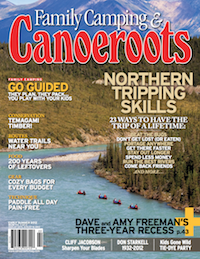 This article first appeared in the Early Summer 2012 issue of Canoeroots Magazine.
This article first appeared in the Early Summer 2012 issue of Canoeroots Magazine.




